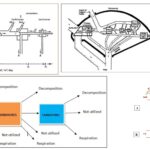Botany 34 Views 1 Answers
Sourav PanLv 9August 22, 2024
What is meristematic tissue and its function?
What is meristematic tissue and its function?
Please login to save the post
Please login to submit an answer.
Sourav PanLv 9May 15, 2025
Meristematic tissue is a type of plant tissue that is responsible for the growth and development of plants. It consists of undifferentiated cells that have the ability to continuously divide and produce new cells. These tissues are crucial for plant development as they give rise to various tissues and organs of the plant.
Functions of Meristematic Tissue
- Cell Division and Growth:
- Primary Growth: Meristematic tissue contributes to the primary growth of the plant, which increases the length of stems and roots. This is achieved through cell division in the apical meristems located at the tips of shoots and roots.
- Secondary Growth: In woody plants, meristematic tissue in the lateral meristems (vascular cambium and cork cambium) contributes to secondary growth, increasing the girth of stems and roots.
- Tissue Formation:
- Differentiation: Meristematic cells differentiate into various types of specialized cells and tissues, such as xylem, phloem, and parenchyma. This process helps in forming different plant structures and organs.
- Regeneration and Repair:
- Wound Healing: Meristematic tissue aids in the regeneration and repair of damaged plant tissues. It helps in forming new tissues to replace those that are lost or damaged.
- Organ Formation:
- Root and Shoot Development: Meristematic tissue at the tips of roots and shoots is responsible for the development of new roots, stems, leaves, and flowers.
- Adaptation to Environmental Changes:
- Growth Adjustment: By continuously producing new cells, meristematic tissue allows plants to adapt to changes in their environment, such as changes in light, water availability, and mechanical injury.
Types of Meristematic Tissue
- Apical Meristem:
- Location: At the tips of roots and shoots.
- Function: Responsible for primary growth, leading to an increase in length.
- Lateral Meristem:
- Location: Along the sides of stems and roots.
- Function: Responsible for secondary growth, increasing the thickness of stems and roots.
- Vascular Cambium: Produces new xylem and phloem.
- Cork Cambium: Produces protective bark.
- Intercalary Meristem:
- Location: Found at the base of internodes and leaf blades in monocots.
- Function: Facilitates the elongation of stems and leaves.
- Root Cap Meristem:
- Location: At the root tip.
- Function: Protects the growing root tip and aids in root penetration.
Meristematic tissue is essential for plant growth and development, ensuring that plants can continuously expand, adapt, and repair throughout their life cycle.
0
0 likes
- Share on Facebook
- Share on Twitter
- Share on LinkedIn
0 found this helpful out of 0 votes
Helpful: 0%
Helpful: 0%
Was this page helpful?




